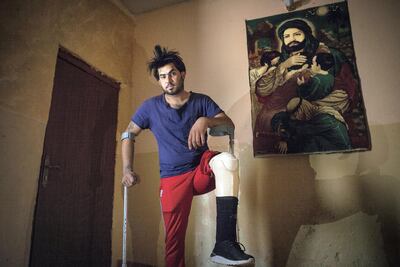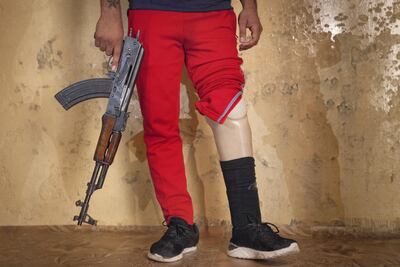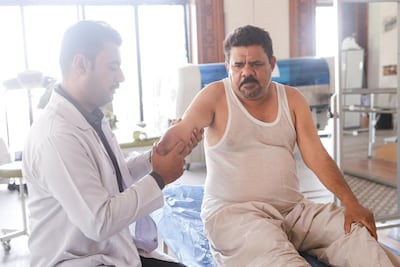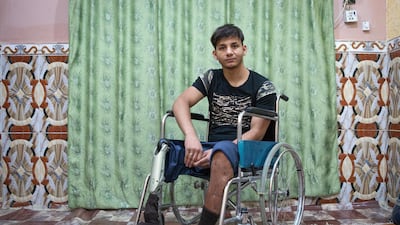The sound of gunfire, explosions and screams cuts through the silence of Jasim Abdulameer's bedroom.
He has heard such noises, for real, in battle. Now, they are virtual, and in a video game he fights enemies on screen.
Inside his parents' home in Khamsa Mil, an impoverished suburb of Basra, is where he spends his days.
The combat game – called Battlefield – takes the 22-year-old back to what was once a very real fight against ISIS. Jasim was a volunteer in Asa'ib Ahl Al Haq, part of the Popular Mobilisation Units, a group of largely Iran-backed Shiite militias.
The PMU – Hashed Al Shaabi in Arabic – became active in June 2014 when Iraq's top Shiite cleric Ayatollah Ali Al Sistani issued a call to arms after the rise of ISIS in the north of the country.
Soon the militias were actively engaged in every major battle, proving to be a decisive element in the fight against ISIS, including the retaking of Mosul one year ago.
_________
Read more:
ISIS attacks resurgent on Iraq’s ‘Highway of Death’
Iraq grapples with Iranian influence ahead of elections
_________
For almost a year Jasim risked his life to fight Abu Bakr Al Baghdadi's terror group alongside his fellow militiamen.
Then on June 7 2015 the house he was in was hit by a mortar, collapsing on top of him and his unit.
"I was the only survivor. Four others died as martyrs. I lost my leg, and the other no longer works," explains Jasim, sitting on his bed next to his wheelchair. After 20 surgical operations doctors decided to amputate his right leg.
"I wanted to be a martyr when I joined the Asa'ib Ahl Al Haq” he said.

One third of the men who joined the PMU in 2014 were from Basra, one of the heads of the militia, Ammar Faris, told The National.
More than 1,500 PMU fighters were killed in battle and 8,000 were wounded. Mr Faris estimates that around 3,000 men were left disabled.
“The defence of Baghdad and south Iraq became dependent on militias,” Ibrahim Al Marashi, an associate professor of Iraqi history at the California State University San Marcos said.
Most of the fighters were unemployed and from poor areas – joining the fight provided them with a monthly income of between $390 and $600.
With only primary school education, unemployed Hassan Naeem joined the Badr Brigade - also part of the PMU - in June 2014.
“When ISIS arrived in Iraq, I felt a lot of anger, seeing these foreigners come to our land and rape our women. I was just waiting for Al Sistani's order to fight” said the 22-year-old.
“I received training for close-quarters combat in Tehran for a month. The instructors were Iraqi, but the managers were Iranian,” said Hassan.

Despite their lifelong injuries, wounded PMU fighters have no regrets.
“I loved fighting. It was an honour. ISIS soldiers would run away, and I would shoot them,” said Hassan. "I've been hit in both legs and in the arm."
“Fortunately, I went to Iran, because in Iraq doctors wanted to cut more of my leg,” explained Hassan, who lost his left leg when a mortar hit him while on patrol on the outskirts of Ramadi, Anbar.
In northern Tehran the Baqiyatallah Hospital, operated by the Islamic Revolutionary Guard Corps, received up to 60 heavily injured Hashed fighters from Basra every week in the months following the liberation of Mosul in July 2017.

Back in Basra, on the banks of the Shatt Al Arab river, one of Saddam Hussein's former palaces was turned into a post surgical centre. Patients are fitted with prosthesis and undertake physiotherapy.
“Amputees account for 10 to 20 per cent of our patients,” said the PMU's Mr Faris. A mental health centre is due to open in 2019.
"In Basra, I have over 500 [PMU] patients with psychological disorders. They're unstable," one doctor said. Most suffer from severe post traumatic stress disorder, added the doctor, who asked that his name not be used for security reasons.
After the adrenaline of war wears off and fighters return to their daily routine, many of them fall into a state of depression.

Sajid Jelil, 25, became deeply depressed when he lost his left leg in 2015. Him and 70 PMU fighters were targeted by a car bomb in a farm in Fallujah, Anbar. "Many died, others were injured and I lost my leg," he said.
To keep himself from slipping into a state of despair, Sajid began coaching a football team, 10km north of Basra. Under the setting sun, parents and children observe him as he kicks the ball around.
But not every amputee has been as lucky as Sajid. Most remain unemployed and live off a bimonthly government pension.
Despite their lifelong wounds, some of the fighters say they would encourage their own children to join the fight if such a threat were to present itself again.
“I’d support my son. His fate depends on Allah, whatever happens to him, it will be Allah's decision” says Hassan, of the Badr Brigades, sitting under a portrait of Imam Ali.
But Hassan dreams of a different fate for himself. "I wish I'd been a martyr rather than disabled," he says under the intrigued gaze of his younger brother. "Being a martyr guarantees that you go to heaven."

